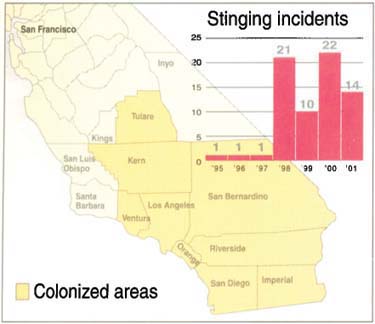All Issues
Africanized bees discovered in central San Joaquin Valley
Publication Information
California Agriculture 56(2):44-45.
Published March 01, 2002
PDF | Citation | Permissions
Full text
UC Davis entomologist Dave Nielsen has identified two Africanized bees in Tulare County, the first time the highly defensive bees have been found in the central San Joaquin Valley.
Last fall, Nielsen sampled about 150 bees from 30 different sites between Atwater to the north and Bakersfield (Oildale) to the south, in the region of Highway 99 and the Sierra foothills. The two Africanized bees were identified near the towns of Lindsay and Posey, using PCR-amplified mitochondrial DNA markers.
“There are a great number of bee colonies in the area,” Nielsen says. “If you don't find Africanized bees, it doesn't mean they're not there. Therefore, our results are a conservative estimate of their range expansion.”
“They're moving up the San Joaquin Valley,” says Scott Kinnee of the California Department of Food and Agriculture's (CDFA) Plant Pest Diagnostic Center. “They're probably even further up than that, but the sampling hasn't been done yet.”
Bees from South Africa were released in Brazil in 1956, and have been slowly making their way northward. California's first Africanized honeybees were discovered in Blythe (Riverside County) in October 1994. More than 51,000 square miles of the state are now considered colonized.
Africanized and European honeybees have the same appearance and venom, and each bee stings only once. But Africanized honeybees guard a larger area around their hives, respond faster and in larger numbers, and can chase their foes for as much as a quarter-mile.
Their impact on agriculture, which relies on bees for pollinization, has been minimal. “Agriculture generally relies on commercial hives from out of state,” Kinnee says. Beekeepers continue to tend their hives, but must be vigilant and replace the queens in aggressive colonies.
Since entering California in the mid-1990s, Africanized bees have slowly made their way northward; the latest confirmed finds were in Tulare County (map). At the same time, reports of multiple stinging incidents (inset) by Africanized bees have increased. Source: California Department of Food and Agriculture.
However, Africanized honeybees tend to colonize niche spaces in urban areas, such as abandoned structures and vehicles, fences and empty boxes. “As the range of the bee has grown, there has been increased contact with areas populated by humans and domestic animals,” Kinnee says. “This has resulted in a rising number of stinging incidents.”
Seventy incidents of multiple stinging were reported to CDFA between December 1995 and late January 2002, when a 5th-grade boy in West Covina (Los Angeles County) was stung after throwing rocks at a hive.
For more information, go to: www.cdfa.ca.gov/phpps/pdep/ahb_profile.htm





